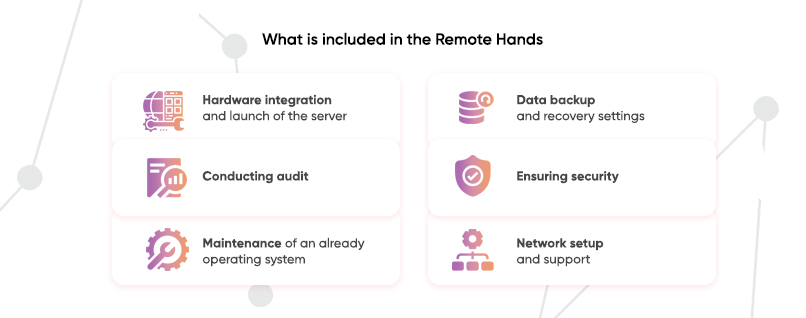Contents
The Remote Hands service is a technical support of server infrastructure by a provider or special companies that are professionally engaged in system administration. Assistance in server management is needed when your own resources or competencies are insufficient to solve problems or fulfill tasks related to the administration of IT systems. Technical support can be provided both at the level of hardware maintenance and at the level of tasks related to the operation of software. Large European providers also offer their clients real-time server monitoring services as part of the Remote Hands service.
When remote technical support is required
 The Remote Hands service is used by both small companies that do not have the opportunity to keep highly qualified IT specialists on staff, and large companies that need the help of a contractor.
The Remote Hands service is used by both small companies that do not have the opportunity to keep highly qualified IT specialists on staff, and large companies that need the help of a contractor.
There may be following reasons for using the service:
- There is no on-staff administrator with the right skills or the person who maintained the IT system has left the company.
- Occurrences of glitches and issues with data access.
- The load on the servers has increased and the system is running slower.
- IT infrastructure should be upgraded to a more complex functional level and new services have to be implemented.
- One-time services are required: you need to expand the server disk subsystem, increase the capacity (put additional processors in free sockets), organize a distributed database, create a geographically distributed cluster for backup, etc.
- An incident or accident has occurred, and there are no existing maintenance contracts.
Most often, clients require assistance when they are unable to handle an incident or difficult task on their own.

In our practice, there was a case when a factory producing metal products faced an accident in the data storage system: one of the server modules on which the enterprise resource planning (ERP) database was located burned down. Prior to the incident, the IT infrastructure had been working steadily for 7 years, and the plant administration had not entered into any technical support contracts with anyone. When it was necessary to restore the system operation, it turned out that none of the regular IT specialists knew how the storage was connected with the database. The plant administration asked the hardware vendor for help, and the vendor forwarded the request to the manufacturer. The manufacturer offered to purchase an annual technical support service (paid around €5,000 for the right to write letters). To avoid wasting time, the plant turned to us for assistance, so we conducted an audit and within a few days restored the operation of the hardware and software.
Pavel Sabirjanov
Services Offered by the Major Data Centers in Europe as Part of the Smart Hands

Remote technical support helps to solve a wide variety of tasks related to server configuring and administration: from initial installation of hardware, to auditing and maintenance of already running systems and services.
- Hardware integration and launch of the server. Integrating, launching and configuring a new server are time-consuming and complex processes. Hiring a contractor with specialized skills saves time in almost all cases and helps to avoid unforeseen issues in the future.
- Conducting audit. Analysis of systems for compliance with technical standards and business requirements. The audit allows you to assess the current state of affairs and prepare a plan for updating, optimizing or reforming the IT infrastructure.
- Maintenance of an already operating system. The provider will help troubleshoot problems, update software, and perform preventive maintenance on hardware.
- Data backup and recovery settings. Connecting backup storage, configuring backup and data recovery settings are tasks that require a highly qualified administrator. If the company does not have an IT specialist capable of preparing a full-fledged DRP (disaster recovery plan), it is better to entrust this work to a contractor
- Ensuring security. Remote technical support is beneficial when it is necessary to customize server security systems: install anti-virus software, configure data access levels, fix vulnerabilities and assess the risks of the running IT infrastructure.
- Network setup and support. Specialists will help you configure protocols, create routing configuration (data exchange between different networks and load distribution), set up virtual LANs (organization of several network layers with different access parameters: visitors, employees, management) and VPNs (creation of a private secure network via a public network, for example, Internet), install firewalls and protection against DDoS attacks.
Server support and monitoring
Real-time monitoring of server operation is another very useful service that providers can offer as part of the Remote Hands service. Active monitoring of hardware and software operation minimizes the risk of emergencies and failures. Even in case of an incident, specialists always know how to fix the situation effectively and as quickly as possible. Modern technologies make it possible to monitor a huge number of parameters:
- Availability of the server or applications/services deployed on it.
- Correct operation of the operating system, database and applications.
- Performance of network resources, including routers and switches.
- Response time.
- Memory usage and data storage capacity.
- Traffic flow rates.
- Hard disk drives and network infrastructure load.
- Physical events (system unit opened, temperature in the server room changed, etc.).
- External attack occurrences.
The client can always negotiate monitoring options separately with the provider or the company that will provide monitoring services.
Managed monitoring solutions for IT infrastructure: ensuring seamless operations
Active monitoring is required for almost any large company that needs to ensure continuous operation of deployed services and applications. If infrastructure downtime for an hour has a critical impact on business metrics, it is a clear indication that monitoring should be enabled.
IT infrastructure monitoring is necessary when you need to control the operation of a large number of servers, devices and services. Active monitoring allows you to minimize the risks associated with local hardware or software failures, maintenance personnel errors. You can configure triggers of monitoring systems to prevent possible incidents (hard disks are almost full, software licenses expire, etc.) with the ability to send notifications to the technical support service.
If a company has many offices or sales departments, a monitoring system helps to track all connected servers, access control and video surveillance systems, and critical peripheral equipment (such as cash registers and ATMs). This makes it possible to monitor complex internal and external peripheral infrastructure in a single monitoring center.
Service functions on a subscription basis
Large European providers often offer their clients technical support on a subscription basis. The mechanism of this service is similar to insurance: the provider will replace any broken components free of charge if the client pays a monthly subscription fee. The cost of the service will directly depend on the type and quantity of hardware, manufacturer of components, as well as on the selected terms for technical support. The client can select one of the two possible service options:
- Full day 24/7. The hardware is replaced within 8 hours from the moment of failure, regardless of the day of the week or time of day. This option is best suited for companies working with highly loaded IT infrastructure, when any breakdown increases the level of risk or directly reduces system performance.
- Next business day. Technical specialists will replace the hardware within a business day or on the next business day after the breakdown. This option is best suited in cases where all important components of IT infrastructure are duplicated and the failure of individual components or even an entire server does not critically affect the performance of the entire system.
The terms of service on a subscription basis explicitly apply only to the replacement of physical components. Software licensing and maintenance issues are stipulated in separate agreements.

Technical support for a monthly fee is a relatively inexpensive service. For example, for one Fujitsu DX100 S3 storage system on a "next business day" basis, the cost is only €60 per month. In the "full day 24/7" format, the subscription fee would be €95 per month.
Pavel Sabirjanov
Advantages of the Remote Hands service
There are several obvious advantages of the Remote Hands service at once:
Comprehensive approach. A provider or a company providing remote support services usually not only undertakes to perform a specific task, but also conducts a complete analysis of the IT infrastructure: they assess the quality and performance of the equipment, check the operation of the software, calculate the risks and offer a model of technical support depending on the situation. The client gets the opportunity to quietly go about their business without having to think about the technical side of the issue.
Assistance of technical support service. The ability to contact the technical support service and receive advice at any time of the day is another important plus of the Remote Hands service. In-house administrators are not always able to cope with difficulties, and in some cases they simply cannot do without the provider’s help. To solve urgent issues, there should always be a prompt communication.

You can confidently judge the level of service by the quality of the technical support service. If the technical support specialists just formally answer your queries and only offer standard solutions provided for in the instructions, this is a reason to think about the quality of the provider's services. Technical support team should demonstrate a desire to understand the essence of the problem and provide real help.
Pavel Sabirjanov
Flexible payment terms. Most European providers have an hourly payment system for the Remote Hands service. This is due to the fact that clients usually need one-off help or a contractor for a short-term project. The average cost is approximately €90-150 per hour, but the client can also enter into a long-term agreement to his advantage.
Recently, however, it is increasingly common to see a cost of €70 euros on the service providers’ websites. It is important not to be in a hurry to apply, as it is very likely that in this case the cost for 30 minutes is indicated. Such marketing ploys are made in order to attract the client’s attention and to announce the full cost of the service after preliminary verbal agreements have been reached.
Rack, unit, and server space rental in data center in Europe
Write us a message to get additional information.
or book a free consultation
Especially for you, we have researched the rates for the Remote Hands service from 20 major European providers. You can download a checklist with this information here.

Article author
Pavel Sabirjanov
network engineer and a consultant in network design, escalation support, network administration, and systems administration
